Choosing the right product is crucial for success on Amazon. You have retail arbitrage and private label selling as two main strategies to choose from. Retail arbitrage involves reselling products at a markup, but it’s limited by the need for constant product sourcing and direct competition. In contrast, Amazon’s FBA private label selling offers a more scalable business model without the need for handling inventory. This option allows for increased profit potential.
If you’re interested in building a sustainable and scaleable Amazon business private label products is a promising strategy. With the right seller optimization tools and dedication, you can find profitable products to sell. Get started with our “How to Sell on Amazon” video below and then follow these 5 steps to kickstart your Amazon journey.
1. Get Creative!
First, you need some basic product ideas. Think about your daily life. What items do you use most often? Is there a product you currently use that could be improved? If you can find a product you’re passionate about to sell on Amazon, you’ll find the work involved less tiresome. Thinking about things you like or enjoy will also help to get your creative juices flowing. Try to think of products that meet these guidelines:
- A sale price between $15 and $50 – The lower the sale price of your product, the lower the investment costs, so if you are on a budget, you will probably want to go with a product that sells for under $35.
- Lightweight and easy to ship – Items that are heavy, large or oddly shaped can skyrocket your shipping and storage costs. Try to find items that can fit in a small box and weigh under 3 pounds including the shipping materials.
- Items that won’t break during shipping – Especially if you’re a newer seller, you don’t want to take the risk of selling a product that could break on its way to customers. This can lead to bad reviews that bring down your business quickly. Additionally, breakable items require more complicated packaging and thus higher shipping costs.
- Non-seasonal items – While it may be tempting to get in on a seasonal item or hot trend, this isn’t a good idea if you’re looking for a sustainable product in the long-run. You may make some quick cash, but as the weather or trend changes, sales will drop off, leading to cash flow problems or unsold stock that you can’t move. Focus your ideas on evergreen items that will sell year round.
This outlined criteria is a great starting point if you’re just getting started on Amazon. Products that do not fit this criteria can certainly be home-runs, especially for someone with a little bit more Amazon experience or with a bigger budget.
2. Leverage Amazon
One of the best places to get ideas for what to sell on Amazon is on Amazon itself. The Amazon Best Sellers List can give you tons of ideas about what is currently selling well on the site. Keep in mind that some of the products featured here may be selling well due to seasonal trends, but it’s still a great place to go for inspiration. The page is updated hourly and broken down by category, so you can see best selling items for every single selling category on Amazon.
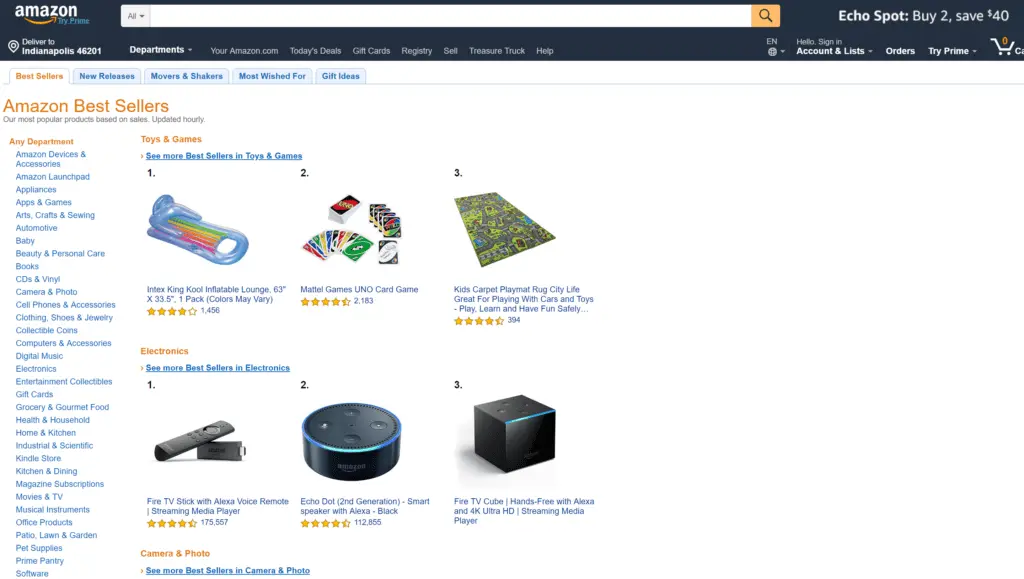
The tabs across the top allow you to see more narrowed results, with tracking for certain types of best sellers. The New Releases tab tracks new listings with an upswing in sales, while the Movers and Shakers tab tracks items that are quickly moving up in Best Seller Rank (BSR). The Most Wished For tab is a great place to get an idea of what customers currently want. While it doesn’t signify sales, it does point to those items that Amazon users are adding to their wish lists most often.
3. Utilize Product Idea Tools
If you like making data-driven decisions and want to quickly determine which products are most likely to succeed, subscribing to a product finder tool may be the best route for you. Tools like Product Discovery from Viral Launch will organize mountains of Amazon data into one convenient place so you can quickly search for new ideas by product, keyword, brand or category.
This tool allows you to select as many Amazon selling categories as you’d like, input price range, average monthly sales, average review count and much more. It’s loaded with advanced filters that allow you to narrow results to personalize your product ideas and quickly identify the highest opportunity products.
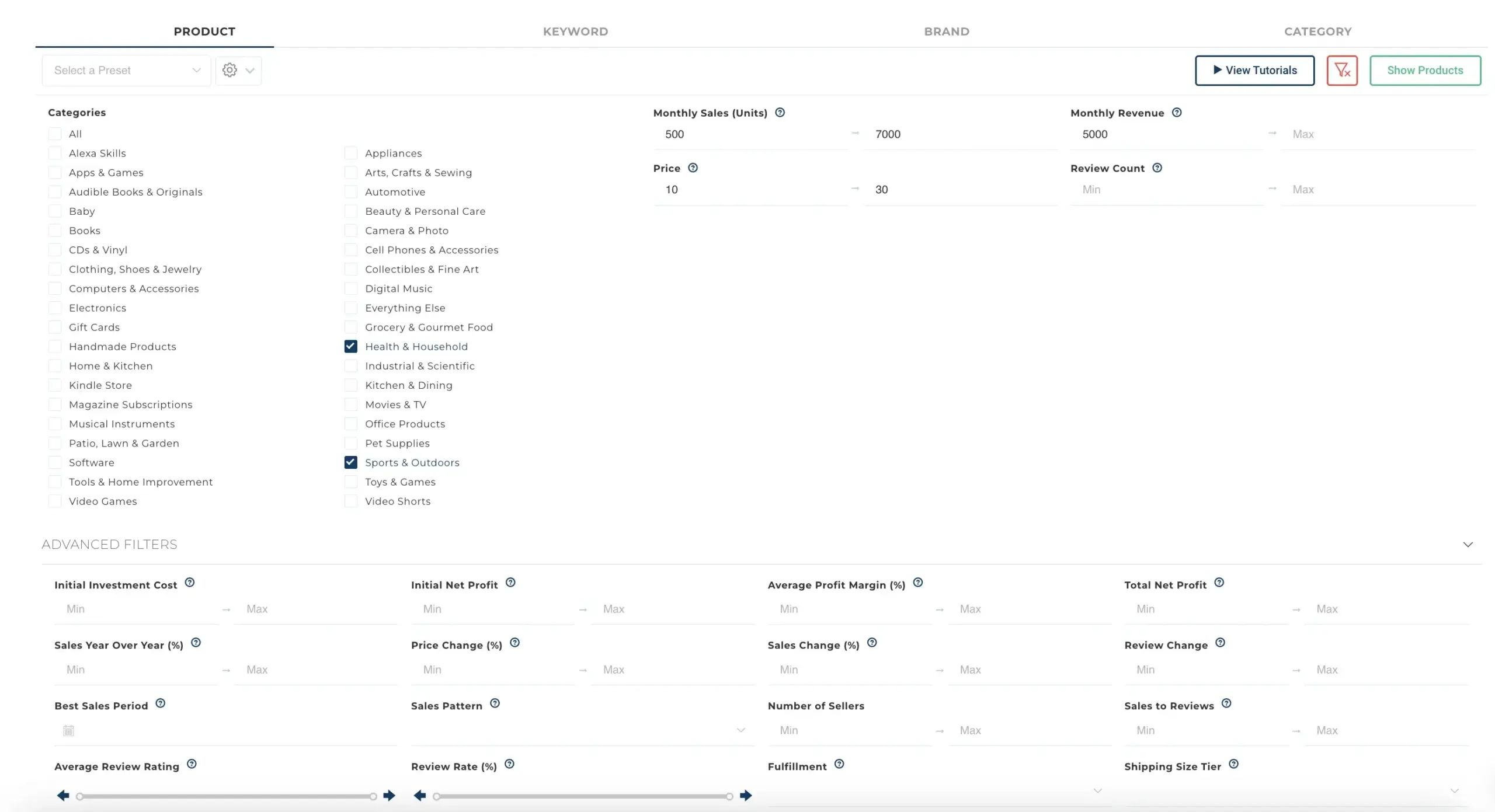
Once you input all your requirements and click the “Show Products” button, Product Discovery scours the depths of Amazon to find current products that fit within your search requirements and organizes them into a list of results.
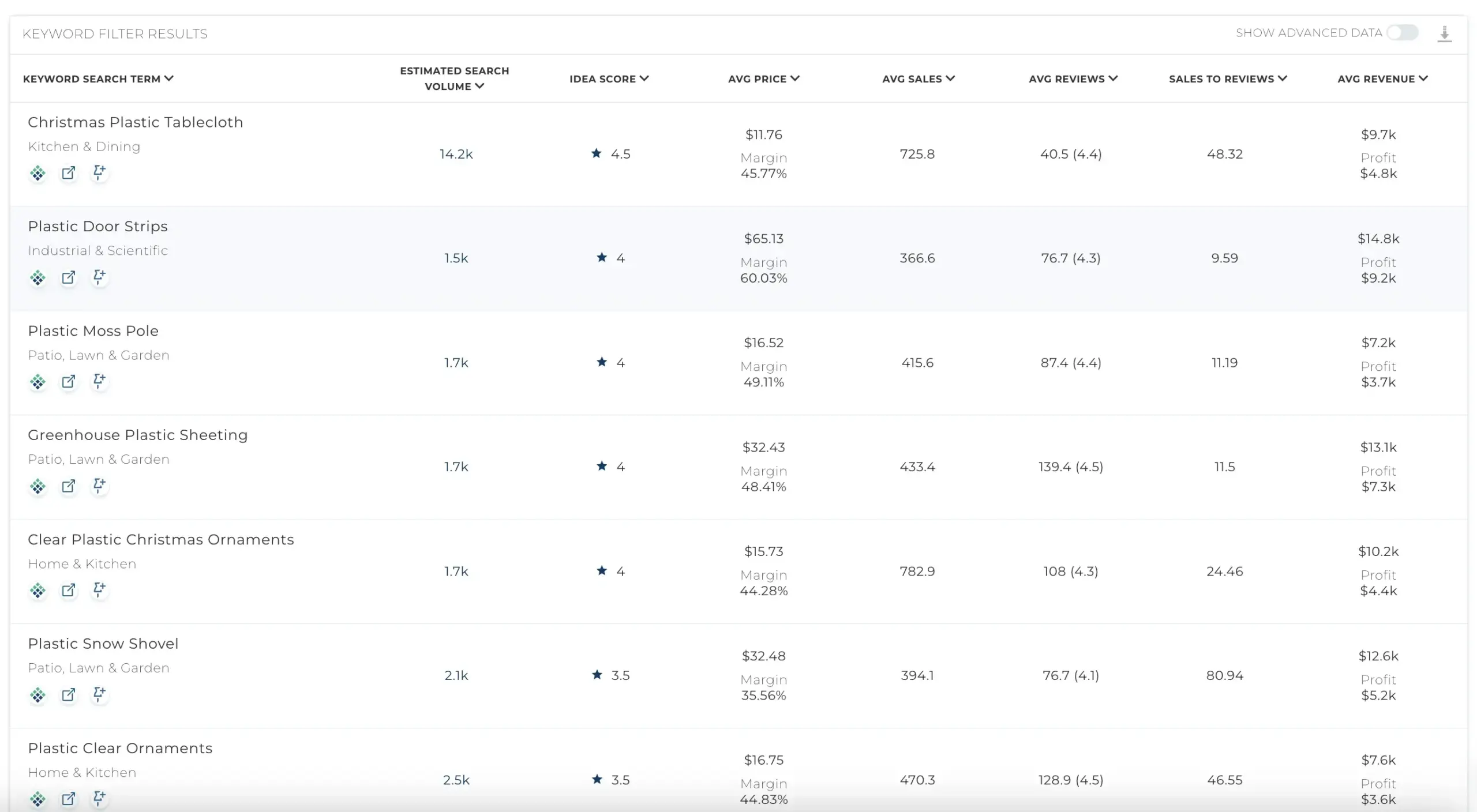
Now you can easily browse the best product ideas on Amazon and see all relevant Amazon data for each product. You can start forming a list of products that pique your interest with the Pinned Products feature. With an annual subscription, each result is also given a product idea score between one and five stars, with five being the best score. This gives you a quick identifier to easily find the best opportunity markets.
Though all the filters and results can seem daunting at first, there are plenty of tutorials to explain the best way to utilize all the features in Product Discovery. Start experimenting, and you’ll quickly be on the path to sourcing your next big money maker.
ProTip:
Make sure you’re looking at the right product market when you research. While a market like “wireless charging speaker” may seem like a great opportunity with high sales numbers and low competition, there are actually only about 75 people searching for that phrase each month.. So the top selling products are likely getting their sales through a keyword like bluetooth speaker with much higher search volume. Make sure you’re looking at the main keyword (and so the main market) for your product when you do your market research. You can verify a market by looking at search volume using a keyword research tool. And you’ll want to use one that utilizes only Amazon data. Sales volume alone may indicate that a product is popular. However, you want to know exactly what kind of product people are searching for so that you can meet the need.
Check out this article to learn more about which Amazon products are the most profitable.
4. Analyze the Market
Once you have some good product ideas, it’s time to get down to the research. It’s important not to overlook this step. Just because you’ve identified some product markets that seem to have high sales and search volume doesn’t mean they will be gold mines. The market may be oversaturated with competitors. It may be a trendy product on its way downhill. Or, there may be too many high volume sellers for a newbie to compete.
There’s a variety of different reasons why high sales volume doesn’t necessarily translate to a good product idea. But if you do the appropriate market research, you can be sure to find the right product to meet your revenue goals and grow your online business.
Here are some things you want to look for in a product market:
- No big brand name competitors – It’s hard enough to compete with all the products being sold, but it’s even harder if your product is competing against one with major brand recognition. Stay out of markets that are dominated by common household names.
- Look for markets where competitors have a low number of reviews – Reviews play a major role in ranking and sales on Amazon. If all the competitor products on page one of search results have numerous reviews, it’s going to be tough to break into that market as a newbie with no reviews. And it can take months… even years to build up review count. Look at the page one results for your product idea. If the average sales to review ratio for all of the competitors on the first page is less than 2, it’s probably not as great an idea as you originally thought. This means that the number of sales is only double the amount of reviews (or less). For example, your top competitors may be selling 1,000 units per month, but they each have 500 reviews. The sales to review ratio here is 2, and it’s tough to compete because of such a high barrier to entry. Try to find a product where the sales to review ratio is 3 or above, meaning sales are three times the number of average reviews, or more. This gives you opportunity to come in with a solid review strategy and overcome the competition.
- Understand the market trends – In order to get a clear picture of how your product will perform on Amazon, you have to understand the market trend. How has this market performed in the past and how will it continue to perform in the future? Have the sales in this market been steadily dropping over several months? If so, this probably indicates that the market will continue to drop and is therefore not a good place to launch a new product. If however the market is trending upwards, this could be a great time to get into this market. Continue to watch the market during the entire researching and sourcing process to ensure the market is continuing to grow without adding numerous competitors.
Although it isn’t very efficient, it’s possible to complete market research on your own. Simply utilize all the information Amazon gives you. To do this, search your product idea on Amazon. Let’s go with the market “first aid kit” again. When you search this item, you get a page full of results that meet your search query.
When you click on the first result after the sponsored ads, you see the product’s listing. Scroll down to the Product Details section, and here you will find useful information about this specific product:
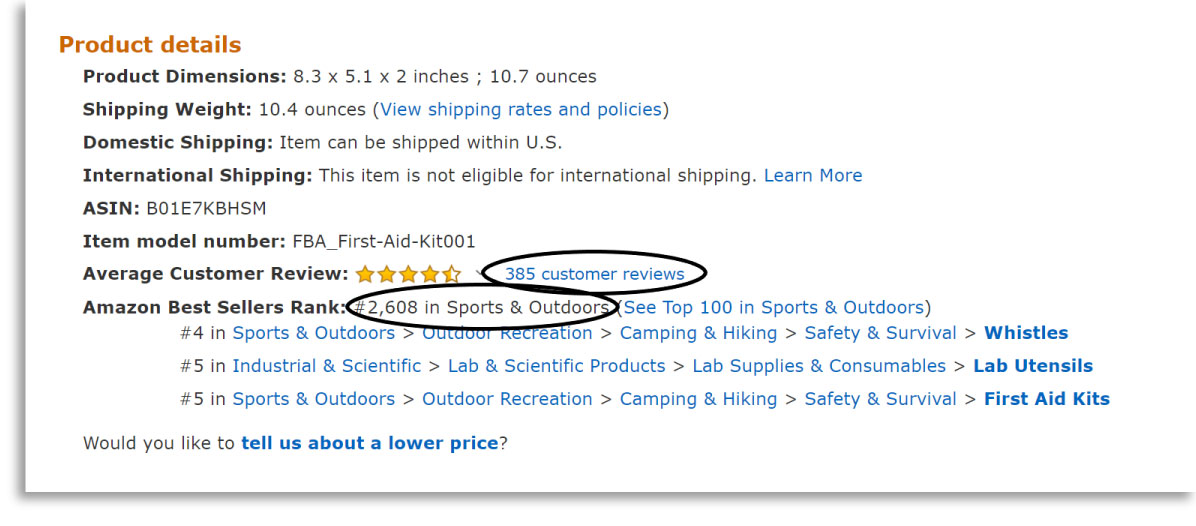
- Reviews – This particular first aid kit has 385 reviews. That is relatively high and would be tough to compete with, but remember this is just one product on a page of many results. It’s important to take the entire market into account.
- BSR – This product is number 2,608 in its broad category of Sports and Outdoors. BSR is an indicator of past sales, and the lower the number, the more it’s selling. Amazon does not release actual sales data, so BSR is an indicator of which products are performing best, relative to others in its category.
When you complete this research for multiple products, you get a clearer picture on whether this is a market that you can compete in. From looking at page one results for “first aid kit” we see that it has a decent potential for sales. Shoppers are obviously buying products like these. There are also multiple results (eight to be exact) on page one with low reviews (under 50, in this case). This means you should still be able to compete as a newcomer.
Let’s Make Things Easier…
Now that you understand how to find all the useful product information on Amazon itself, it’s time to let you in on a little secret. All this market research can be completed quickly and easily with the help of a market research tool like Market Intelligence from Viral Launch. This tool pulls all Amazon data for the top competitors of any market, all within a few seconds.
Continuing with the first aid kit idea, we can search the term in Market Intelligence or use the Chrome extension directly within Amazon, and all the data for the product listings that are ranking for this term will be organized into one place. Here you can see sales estimates, BSR, review data, Amazon fees, monthly revenue and more for all the top competitors of your product idea. You won’t have to painstakingly look at each page one product and gather the data yourself. This tool does all of that for you.
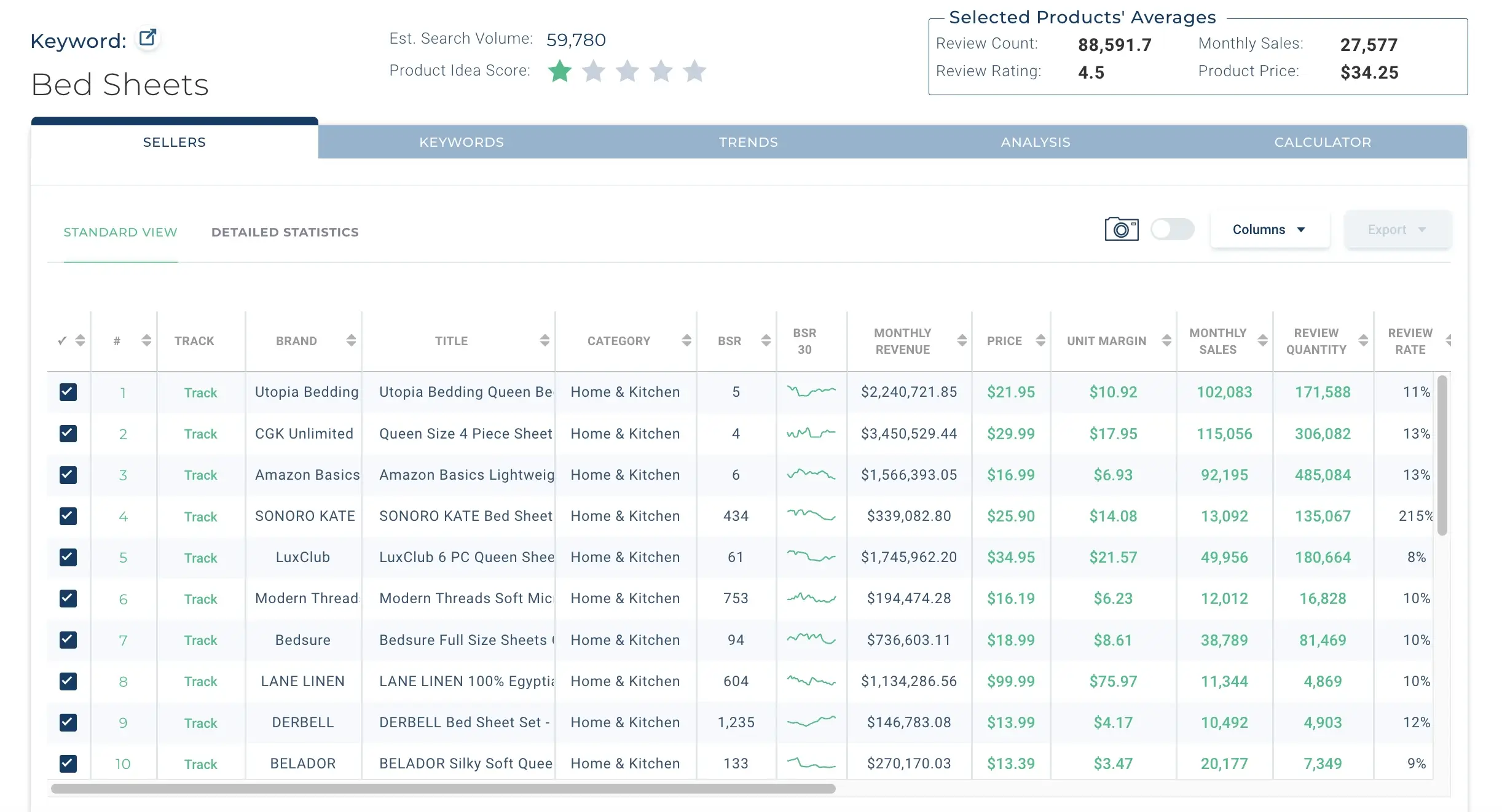
The rows highlighted in red are considered outliers. This is because they have monthly revenue or reviews that are much different than the rest of the products. Market Intelligence flags these results because they don’t represent the average product result. Therefore, they not be used as an expectation of how your similar product might perform. It’s crucial to use averages for your predictions instead of trying to replicate the success of the very top player. If you scroll to the right, you can see even more statistics and data about each product.
The tool also gives you an overall product idea score, allows you to view market trends, see a detailed product analysis and calculate your costs. All of these aspects will help data-loving entrepreneurs to quickly and confidently identify what to sell on Amazon.
5. Read Competitor Reviews
So you’ve done your research and identified a great product idea. Now you need to source a product that is as good as or better than the competition. Price is extremely important on Amazon as many shoppers are focused on finding the best deal. Selling a similar product at a competitive price and marketing it correctly can make you lots of money. However, if you can identify small modifications to make your product stand out, you might make even more.
Read competitor reviews and identify small pain points or complaints that customers have about the item. Look for phrases like, “this product is great, except…” or “I really wish this product had…”.
Find trends amongst these complaints. Do several reviews for different products mention the same problem or wish? Focus on small modifications that will be easy and inexpensive to make. This is where you can set yourself apart without increasing your initial investment cost or the purchase price for customers. If several reviews complain that the product is too flimsy, you easily source a product made of stronger materials
Take These Tips and Build Your Brand
Selling on Amazon can be a very lucrative business that, if done correctly, can turn into a full time career. Finding what to sell on Amazon is a huge part of whether this venture is just a one time experiment or becomes a complete business. Discovering a profitable product will take time but can lead to a growing business and expansion into multiple products. Be patient, do the research and success will follow!







